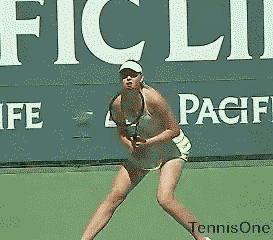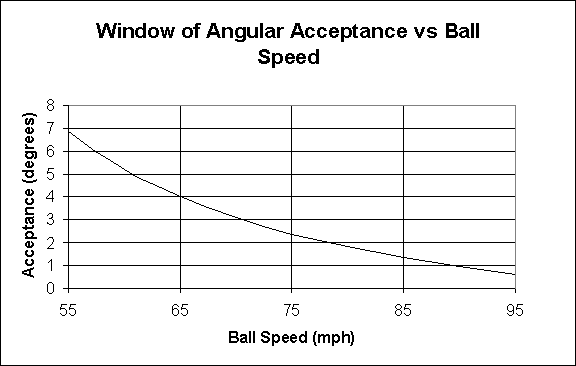|
TennisOne Lessons Windows of Acceptance Howard Brody Once the ball has left the strings of your racquet, there is nothing you can do to influence what that ball does. You can pray, wish, yell and scream, twist your body, or even follow through on your stroke but it will not do any good or influence the ball's trajectory. Once the ball has left the strings it's all over. Newton's Laws of Motion take over and the trajectory of the ball becomes a matter of physics.
An experienced player can observe the initial trajectory of the ball and, from experience, be able to predict approximately where the ball will land, how high it will bounce, how much clearance over the net the ball will have, and how much time the player will have to get to the ball. Since all of this is determined by the laws of physics, it is possible to use the laws of physics to predict exactly what the ball will do, and use that information to a tennis player's advantage. A ball's trajectory is influenced only by the forces acting on that ball. Once it has left the strings, the principal force acting on the ball is the force of gravity, a downward, constant force, which is proportional to the mass of the ball (the name of that force is WEIGHT). As the ball flies through the air, it runs into air molecules, and every collision with an air molecule slows the ball down a little bit. This is called the DRAG force or the air resistance force. The faster the ball is moving, the more molecules it runs into. The faster the ball is moving, the harder it hits the individual air molecules. This means the speed loss per collision increases as the ball speed increases. Putting these two effects together, the speed loss of a ball goes as the square of the ball speed. Double the speed of the ball and the air resistance goes up by four times as much. If the ball is oversize or if it is all "fluffed-up," the drag force will be greater. A head wind, tail wind, or cross wind can also influence the ball's trajectory. If the ball is spinning, there is a MAGNUS force, which can influence the ball's trajectory. Topspin produces a downward force on the ball, adding to the force of gravity. Backspin or underspin produces an upward force on the ball (LIFT), which tends to oppose gravity. Side spin (or slice) will produce a force which will cause the ball to curve to the right or left. The more spin the ball has, the bigger the Magnus force.
When the ball hits the court surface there are forces acting on it during the bounce. They are called the NORMAL force (perpendicular to the surface) and the FRICTION force (parallel to the surface) and they determine how the ball bounces. The spin on the ball before it hits the court surface will also influence how it bounces. As a general rule, after a ball bounces, it will come off the court surface with topspin. A computer program has been written to take all of these forces into account and then the computer program applies Newton 's Laws to predict exactly what the ball will do in its motion after leaving the strings. To accomplish this, the computer program must be given the ball's initial conditions just after it leaves the strings. These initial conditions are:
It is assumed that the ball is a standard (ITF Type 2) ball with a mass and size as specified by the Rules of Tennis. However, the computer program can be modified to allow balls of different mass and different size to be used, as well as adding wind and other atmospheric conditions, such as temperature and barometric pressure. Computer Prediction What is the advantage of using a computer program to predict what the ball will do after it leaves the racquet as compared to going out on the court and hitting balls and seeing what they do? The computer program allows you to see exactly what the ball does as you vary one and only one of the ball's initial conditions. There is no way you can go out on a court and hit shot after shot, keeping all the initial parameters the same except the one you want to vary. If you were interested in how the trajectory changed as you varied, for example, the initial impact height of the ball, how can you be sure that the ball's initial velocity, spin, etc., remained exactly the same as the impact height was changed? (You could buy a ball-throwing machine, install high speed video cameras, and then do a computer reconstruction of the ball's trajectory from the video, but that is expensive and time consuming, and does not give you an immediate answer.) The great advantage of the computer prediction of ball trajectories program is that it allows you to calculate the WINDOW OF ACCEPTANCE of any shot you are interested in hitting. Understanding this windows of acceptance concept is one of the things that distinguishes a smart player from the player who just hits the ball. By understanding this windows of acceptance concept and using it, a player can win extra points, or not lose unnecessary points.
The Concept of Window of Acceptance Some shots are risky — they rarely go in. Some shots are safe — you rarely miss them. What determines the relative safety or risk of a given shot? There are two factors that determine the chances of missing a shot (making an error). One factor is your own ability, how good a player you are, how much you practice, how well you concentrate, how much the result of your strokes varies from swing to swing, how much you unintentionally spray the ball around, how well you can get the ball to end up where you want it to go. This is not a topic we will deal with, since there are many, many other books, articles, and videos that tell you how to improve your biomechanics, your swing, etc. We will just assume the spray of your shots is something this article cannot correct. The other factor — the window of acceptance — will be introduced here and then discussed in this and in subsequent articles. The concept of WINDOW OF ACCEPTANCE is essentially a measure of how large is the probability of a specific tennis shot crossing over the net and landing in the court. If the window of acceptance is large, that shot is likely to be good. If the window of acceptance is small, you are likely to make an error trying to pull off that shot. Let us now explain how the window of acceptance is determined. When you hit a shot (say a groundstroke), for a given ball speed off of the racquet head and a given hitting location on the court and a given impact height and a given amount of spin (these are called the INITIAL CONDITIONS), there is a minimum vertical angle for the ball leaving your racquet that will have that ball just clear the net. For exactly the same initial conditions, there is also a maximum angle of the ball off of the strings that will result in the ball just landing on the baseline. The difference between the minimum angle to just clear the net and the maximum angle (ball lands on the baseline) is the vertical acceptance angle (or VERTICAL ANGULAR ACCEPTANCE or WINDOW OF VERTICAL ACCEPTANCE) for that shot to be good. Anytime that shot is hit with an initial vertical angle between the minimum angle and the maximum angle, the shot will be good. The larger the angular acceptance, the more likely the shot will be good and the less likely you are to make an error hitting that shot. The actual size of the angular acceptance depends on all the other initial conditions (ball speed, spin, etc) that a player has control over. So it makes sense to know how this acceptance window depends on things that are under your control, if you want to optimize it.
Figure 1 shows the computer calculated trajectories of two shots — one that just skims the net (minimum angle) and one that just lands on the baseline (maximum angle). The difference between the minimum and maximum angle is shown, and it is the window of vertical angular acceptance. It is also possible to think of the acceptance in terms of an imaginary window at the net. For a shot to be good, the ball must pass through this window at net. The lower bound of this window at the net is the top of the net itself, while the top of this imaginary window is the height at which a ball that is hit at the maximum angle crosses the net. Any shot that reaches the net below the window will obviously hit the net. Any shot that crosses the net at a height above the top of this imaginary window will land beyond the baseline and outside the court.
This acceptance angle depends on the initial conditions (ball speed, spin, etc) and an example is shown in Figure 2. This figure shows the minimum angle for the ball to just clear the net and the maximum angle for a ball to just land in for different initial ball speeds. The difference between the maximum angle and the minimum angle in this figure is the window of vertical acceptance. The value of this window is plotted against the initial ball speed in Figure 3. Note that the acceptance window decreases as the ball is hit harder, which means you are less likely to get the shot to go in if you hit the ball harder.
Every player, when hitting a groundstroke, has a certain variation, from shot to shot, of initial vertical angle. A good player has a small variation from shot to shot. The player has good "control." A poor player or a beginner has a large variation in initial vertical ball angle from shot to shot. If the variation in vertical angle from shot to shot is small compared to the window of vertical angular acceptance for that shot, then the player is hitting a safe shot and usually will not make an error hitting that shot. If the variation in vertical angle by the player from shot to shot is large compared to the window of angular acceptance of that shot, it is a risky shot and will often lead to an error (the ball will hit the net or sail long over the baseline). Another way of saying the same thing is when a player is hitting into an angular acceptance which is considerably larger than the shot to shot variation of the player's initial angle, that player will be know as a steady player. As previously stated, this article will not discuss or tell you how to reduce your own variation in initial vertical angle from shot to shot (improve your control), but in subsequent articles it will tell you what to do to increase the angular acceptance of the shot you are hitting (how to open up the imaginary acceptance window at the net to allow more shots go through it). There is anecdotal information about how the acceptance changes as the various initial conditions for a shot change and much of this information is well known. For example, most people realize that the harder they hit the ball, the less likely it is for that shot to go in. Or, when you serve, the higher the ball is at the impact, the more likely it is for that serve to go in (which is why you serve overhand instead of underhand and why taller players seem to have better serves). What this computer program can do is put numbers on that anecdotal information and tell you how much more or less likely you are to hit a successful shot when you change one of the initial conditions. The numbers are calculated by using the computer program that determines a ball's trajectory, given its initial speed, angle, height, spin, and location on the court where it was hit. This computer program, as previously stated, is based on Newton's Laws of Motion and measured ball parameters, such as mass, air resistance (drag) and lift (due to ball spin). The diagrams in this article and subsequent articles were obtained using this computer program (written in QBASIC), as are many of the other trajectory diagrams displayed. Your comments are welcome. Let us know what you think about Howard Brody's article by emailing us here at TennisONE.
Professor Brody is a member the International Tennis Federation Technical Commission, the USTA Sports Science Committee, USTA Technical Committee, science advisor to the Professional Tennis Registry, technical advisor to the United States Racquet Stringers Association, on the Editorial Board of the Journal of Sports Engineering, and on the technical advisory panel of Tennis Magazine. His book Tennis Science for Tennis Players was published by the University of Pennsylvania Press in 1987. He and Vic Braden are featured in a video "The Science and Myths of Tennis." As one of the principal authors who have written an NSF sponsored high school physics course (Active Physics), he was responsible for the chapters dealing with the physics of sports. He has received the USPTR Plagenhoef award for sports science in 1996 and the International Tennis Hall of Fame Educational Merit Award for the year 2000. His latest book, The Physics and Technology of Tennis, written with Rod Cross and Crawford Lindsey was published in late 2002. He is also one of the principal authors of the CD-ROM on The Science of Tennis funded by the Lawn Tennis Association Coach Education. At the 2003 Tennis Science and Technology Congress, the ITF gave a prize for the best paper presented and named it the "Howard Brody Award" for his service to tennis. |







 Dr. Howard Brody is an emeritus professor of physics at the University of Pennsylvania , where he was interim varsity tennis coach for part of the 1991 season. He played varsity tennis and earned his bachelor's degree at MIT and his master's and doctoral degrees at Cal Tech. Recently he has been investigating the physics of sports, particularly tennis. He has written many papers and articles on the subject, given numerous lectures and talks on tennis, and done several television programs explaining the science behind tennis, football, and baseball.
Dr. Howard Brody is an emeritus professor of physics at the University of Pennsylvania , where he was interim varsity tennis coach for part of the 1991 season. He played varsity tennis and earned his bachelor's degree at MIT and his master's and doctoral degrees at Cal Tech. Recently he has been investigating the physics of sports, particularly tennis. He has written many papers and articles on the subject, given numerous lectures and talks on tennis, and done several television programs explaining the science behind tennis, football, and baseball.